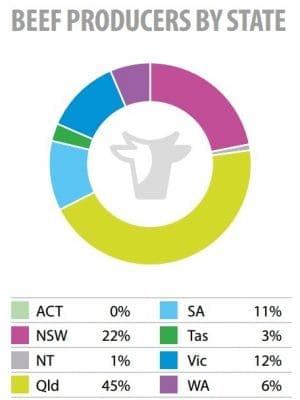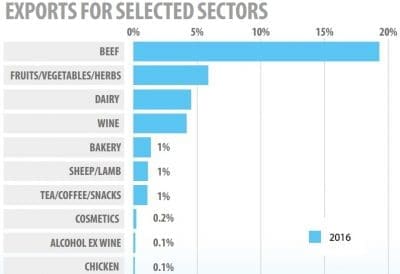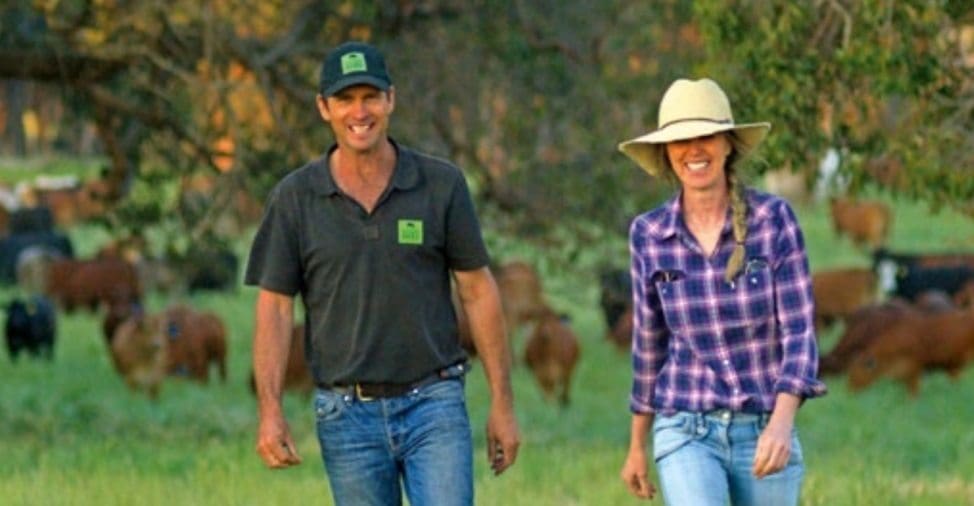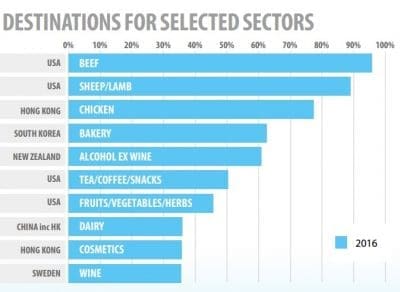WHILE exports fell significantly last year due to drought, beef continues to dominate statistics for Certified Organic food production in Australia, an important biennial industry survey has shown.
The Australian Organic market report released today is based on a comprehensive survey conducted every two years since 2009, using a representative sample of more than 1000 Australian shoppers canvassed for their views and shopping habits around on organic products.
The report suggests that there are indications that organics is moving from a niche position to a mainstream preference for more households in Australia and overseas, at least on an occasional basis. This is especially true of families with young children, with children in the household correlating strongly with a preference for organics.
Organic farmland area rapidly expanding
Australian farmland area devoted to organic production has increased fourfold since 2002, and has increased by 23pc or more than five million hectares between 2014 and 2016, the report said.
The area of land under certified organic management (in-conversion and fully certified organic) in Australia in 2016 was conservatively estimated at 27 million ha – representing 53pc of the world’s total organically-certified farmland. Most of the area under certified organic management in Australia is in the rangelands or pastoral zones, dominated by beef production.
The Australian Bureau of Statistics estimates the total area of farmland in Australia to be 385m ha, which means about 7pc of Australian farmland is currently under certified organic management.
 Regions with pastoral zones dominate the area under organic production; i.e. South Australia, Queensland, Western Australia, NSW and the NT. The Northern Territory has the largest area per certified producer, with 17 certified organic food producers managing on average 86,000ha each, whereas in Tasmania, 79 certified operations manage on average about 50ha each.
Regions with pastoral zones dominate the area under organic production; i.e. South Australia, Queensland, Western Australia, NSW and the NT. The Northern Territory has the largest area per certified producer, with 17 certified organic food producers managing on average 86,000ha each, whereas in Tasmania, 79 certified operations manage on average about 50ha each.
Beef production is the animal sector that involves by far the most organic food producers – almost a third of all producers involved in the segment. The proportion was relatively stable between 2015 and 2016, with the exception of lamb producers, where a greater proportion of organic producers were raising lamb in 2016.
Almost half of all Australian Organic beef producers in 2016 were in Queensland. A small proportion of producers are involved in wild harvest operations, which fell dramatically from a little over 4pc of all organic beef producers in 2015 to about 1.5pc in 2016. In 2016, most wild harvesters were located in NSW (40pc) and Queensland (16pc).
US dominates export trade in organic beef
In terms of Australia’s organic food exports last year, beef was easily the top commodity by volume, at close to 20pc of all organic exports in 2016. Horticultural produce, dairy and wine all contributed around 5pc.
That statistic for beef came despite a 14pc decline in beef exports over the previous year due to drought. Most other commodities showed volume growth, including sheep/lamb meat, dairy products and chicken all expanding rapidly.
The US dominates overall in terms of market destination for Australian exports of organic products, taking 90pc of all our organic beef exports and 88pc of lamb/sheepmeat. About 56pc of US imports of all Australian organic produce was organic beef. Next largest destinations were South Korea, China, Hong Kong, and Singapore.
exports and 88pc of lamb/sheepmeat. About 56pc of US imports of all Australian organic produce was organic beef. Next largest destinations were South Korea, China, Hong Kong, and Singapore.
In 2014, the total value of the Australian organic market (including domestic and export sales) was estimated to be A$1.72 billion, the report said. That figure will be updated in next year’s report, taking advantage of results from the Australian Bureau of Statistics’ five-yearly farm census.
What organic products are shoppers buying?
Red meat continues to be one of the most popularly purchased of all Organic foods consumed in Australia.
Forty three percent of households surveyed said they had purchased organic red meat at least once during 2016, up from 37pc in survey two years earlier. In the equivalent 2010 survey, the figure was 33pc.
Fruit and vegetables remained the most popularly purchased organic item in 2016, with 61pc of respondents saying they had made at least one purchase. That was followed by dairy (47pc), home-cooking ingredients (44pc), red meat (43pc), bread (41pc), poultry (37pc) and eggs (31pc).
Frequency of purchase for beef declined to just 28pc when respondents were asked if they had made a purchase in the past 30 days, however. That was a decline from 32pc two years earlier.
Most organic shoppers buy infrequently in the majority of categories, which suggests there are opportunities to encourage greater frequency of buying, which would have an influential overall impact on the size of the organic retail market, the report said.
Price or value is the top constraint for both organic shoppers and those who do not buy organic. However, after price, the next top three barriers for organic shoppers are quite different from the next top three for people who do not buy. Organic shoppers are hungry for more information, improved access, better quality and easy identification. Non-purchasers are more cynical and exhibit a growing reluctance to consider organics.
Where are shoppers buying organics?
Supermarkets remain the dominant retail outlet for organic foods, and their business is growing.
Woolworths reports total organic product sales increased by $60 million in 2015. However, retailing of organics is becoming more competitive and diverse. Consumers’ preferred shopping outlets are broadening, with increasing opportunities for smaller, more focussed outlets and alternative retailing channels. Though supermarkets remain the main organic retailer in Australia, there has been a shift towards specialty stores for organic items, mirroring the US experience where this trend is most pronounced amongst the younger Millennial/Gen-Y demographic.
Demand far outstrips supply

Alister Ferguson
One of the Organic supply chain participants profiled for the report was Alister Ferguson, CEO of the Arcadian Organic & Natural Meat Co. He pointed out that demand for Organic red meat consistently outstrips supply.
“There is always a need for more red meat producers and market growth is dictated by supply, which will be limited in the next 12 to 18 months due to the previous drought and herds currently in the rebuilding phase of production,” Mr Ferguson said.
He said the best business decision the company had made in the past five years had been to understand and align its products with current food trends and consumer preferences.
Arcadian has the largest certified organic livestock producer network in Australia, with 130 producers. Eight new products have been added since the company was profiled in the last Australian Organic Market Report in 2014. This includes products in its ‘paleo’ range under the Cleaver’s brand, winning the ‘Best Organic Food Product’ award at the 2015 Australian Organic Annual Awards. Currently Arcadian employs 77 people, up 20 compared with two years ago.
Mr Ferguson attributes this to the growth of the business, demand for its products and a greater focus on marketing and finding out what the consumer wants.
Organic producer profile: Blackwood Valley Beef

Blackwood Valley Beef was established by the Pensini family in Western Australia in 1976.
The business became certified organic in 2007, prior to which the Pensini family produced grassfed beef using holistic grazing management.
According to Warren Pensini (pictured above with wife Jane), the family saw organic certification as an opportunity to value-add its product. The fairly substantial premium available for organic beef at this time, which Blackwood Valley Beef has managed to retain, has virtually disappeared for many other WA organic beef producers.
Blackwood Valley Beef exports about 10pc of its product to Singapore, with the potential to increase this to 50pv in the next 12 to 18 months because of growing demand.
The domestic market will see the addition of value-added products including a range of certified sausages and hamburgers.
Mr Pensini says one of the lessons learnt by Blackwood was that just being organic was ‘not enough’ in the market place.
“A high quality and safe product where the customer has an excellent eating experience are also required,” he said.
He suggested a failure by some organic beef producers to supply animals with high eating quality could explain the closing of the price gap in some regions between organic and conventional beef.
Plans for 2017 include management improvements designed to finishing cattle more consistently year round, as there is demand in the marketplace. Improving the farm operations is expected to increase sales fourfold, which involves focusing on soil health, growing quality pastures and improving herd genetics with a particular interest in selecting bulls for eating quality.
Blackwood Valley Beef will also work with suppliers to improve herd genetics, as in Mr Pensini’s view, one of the limitations to business growth is the lack of availability of high quality organic feeder cattle in WA.




HAVE YOUR SAY